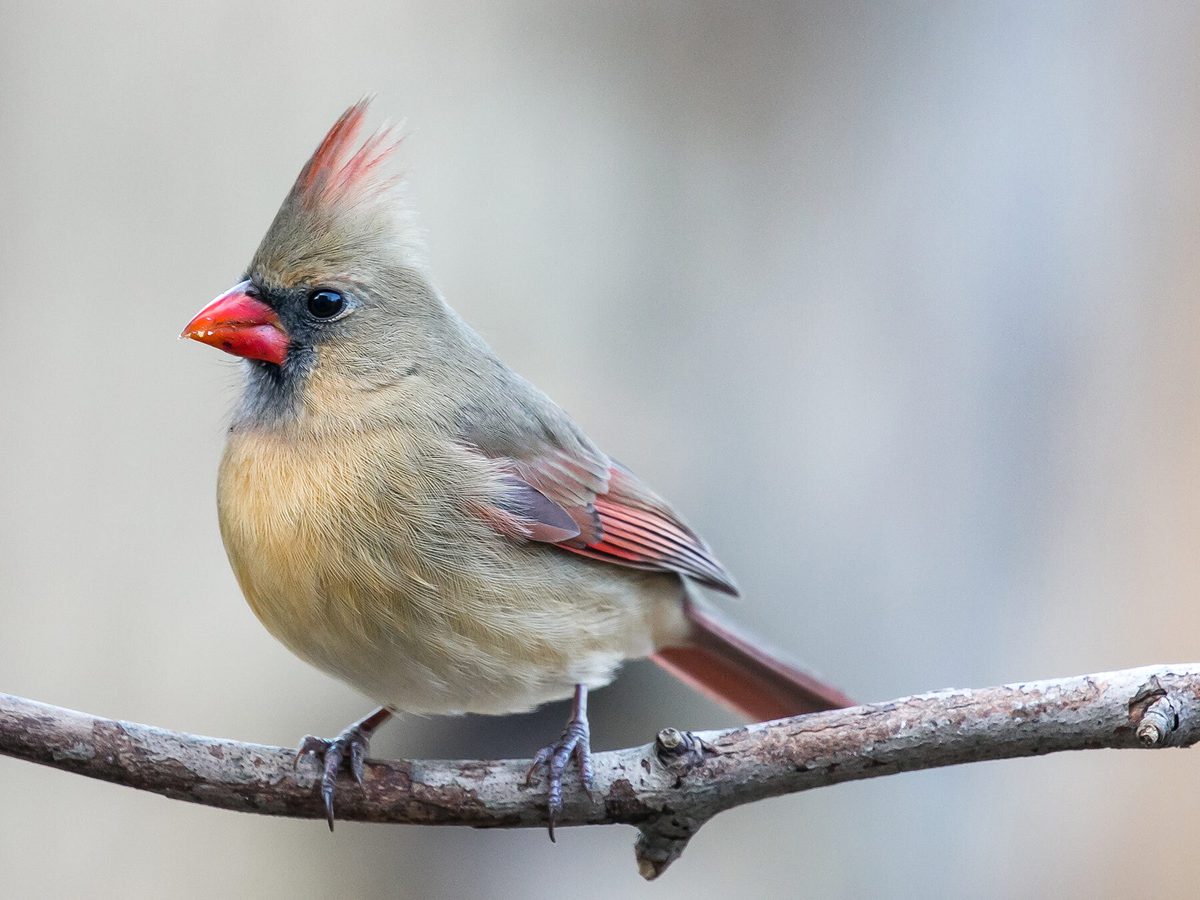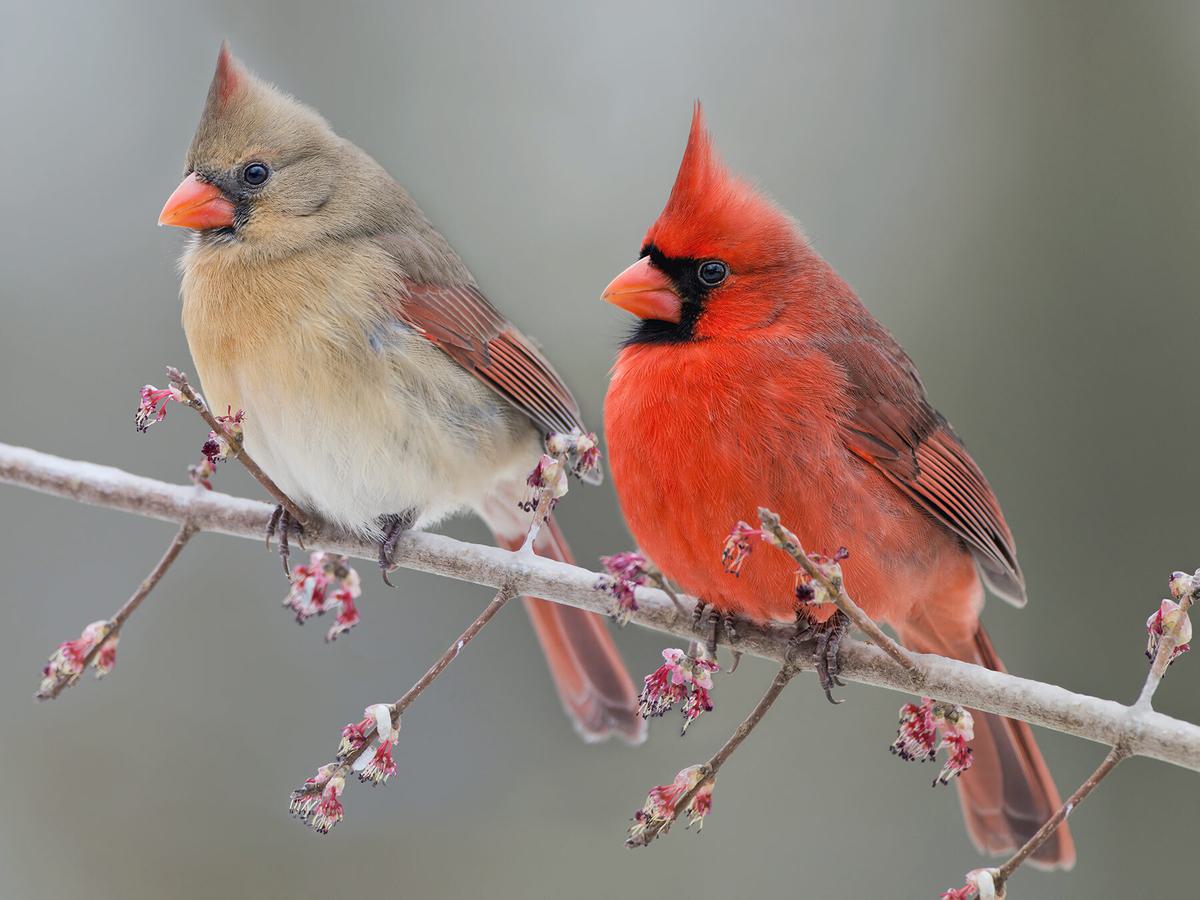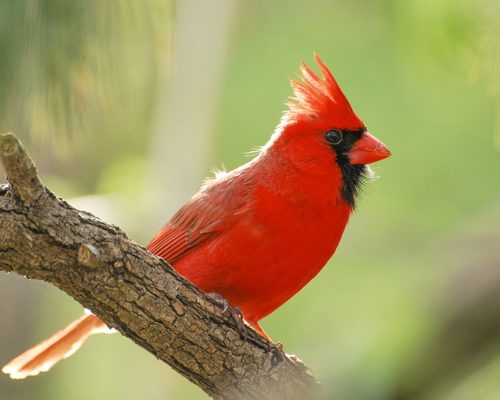Cardinals are undeniably striking birds from the family Cardinalidae, which contains three species; the well-known Northern cardinal (Cardinalis cardinalis), the Vermillion cardinal (Cardinalis phoeniceus) and Pyrrhuloxia (Cardinalis sinuatus), or the Desert cardinal. While people recognise cardinals for their bright red color, only the males sport this fiery plumage.
Female cardinals are still beautiful birds, but there are some crucial differences between them and the males. This is a complete guide to female cardinals.
Female cardinals look different to males for all three species of cardinals. Male Northern and Vermillion cardinals are predominantly bright red with tall, distinctive crests. The Desert cardinal looks different and is much duller, with grey sides and a shorter crest.
Female Cardinals swap out most of their bright red plumage for a drab grey-brown color covering much of their body and wings. This difference in coloration is called sexual dichromatism. Female cardinals are also slightly smaller than males.

Female Northern Cardinal (Cardinalis cardinalis) perched on a branch
Male and female cardinals have different roles when it comes to breeding, nesting and raising chicks.
Male cardinals evolved such bright feathers to help them attract mates and compete with each other; that’s why the males need them, and the females don’t!
Besides the color of their plumage, male and female cardinals are similar in more ways than they are different.
Read on to learn more about female cardinals, their appearance, behaviour, and role in cardinal society!
What does a female Cardinal look like?
Female cardinals are mainly grey-brown, grey-green or olive. Their outer upper wings are still a red-orange color, though they are duller than the males. Their backs and wings are a darker hue than their breast and throat, which is almost white.
Some female cardinals also have small quantities of red feathers around or under their eyes. Whilst female cardinals share the same facemask as males, they are generally less pronounced and are more grey than black.
In terms of shape and size, female cardinals are less upright than males and have a more squat overall posture. They are slightly smaller than the males (less than 5% difference).

Male (right) and female (left) Cardinals perched on a branch together
What is the difference between a male and female Cardinal?
The best way to tell the difference between male and female cardinals is by their plumage. Female cardinals are predominately a brown color all over, which is much duller than the vibrant red plumage of Northern Cardinal males.
Female cardinals look different to male cardinals in a few ways, both in appearance and behaviour:
Plumage
The plumage of female cardinals differs from the males for all three species; the Northern, Vermilion and Desert cardinal. Whilst males are almost 100% red, barring their distinctive black face mask and duller upperwings, females are predominantly brown-greyish with a hint of green in some subspecies.
Their brown-green-grey color is sometimes described as olive. The female does have red and orange-tinted underwings, but the male has almost wholly red underwings.
Females still have orange-red outer upper wings and an orange-red tail, but are much duller overall.

Female Cardinal perched on a branch
A female cardinal’s abdomen is typically brown-white. Female cardinals still possess the same black facemask as males, and their crests are still red, though they are generally shorter and a little duller. Their bills are almost identical to male cardinals. Oftentimes, the black face mask is duller, greyer or less pronounced than the male.
The visual differences between male and female Pyrrhuloxia (Desert cardinal) are much more subtle. Whilst the Northern and Vermillion cardinals are predominantly bright red, the Desert cardinal only has small portions of red plumage on its sides.
This red plumage is almost entirely absent for the female and is replaced by a pinkish hue. Overall, male and female Desert cardinals look very similar, so don’t automatically assume one is a female just because it isn’t completely red!

Female Pyrrhuloxia (Desert Cardinal) taking a drink
The bill color of male and female cardinals is the same. Vermillion cardinals have grey-blue bills, Northern cardinals have red-orange bills, and Desert cardinals have yellow bills.
Female cardinals do also share the same red crest as males, though generally less pronounced and grey at the base.
Size and weight
The female cardinal is slightly smaller and lighter than the male:
Male cardinal size: 8.7 to 9.25 in (22.2 to 23.5 Cm)
Male cardinal weight: 42 to 48 grams (1.4 to 1.5 ounces)
Female cardinal size: 8.2 to 8.5 in (20.9 to 21.6 cm)
Female cardinal weight: 38 to 42 grams (1.4 to 1.5 ounces)
As we can see, the difference in size and weight is subtle. Moreover, males are slightly more upright in posture than females, likely to showcase their bright plumage as a sign of their health, and to make them more conspicuous in their territories.

Male cardinals are generally a bit bigger than females
Behavioural differences between male and female cardinals
Both male and female cardinals are fiercely territorial birds. Some cardinals are quite social in the winter outside of the breeding season, joining calm flocks. But, in the breeding season, cardinals retreat to their pairs and establish territories - and then they’re not so calm anymore!
In the breeding season, male cardinals become particularly aggressive, both with other males, other birds and females. Their song is louder and more aggressive than the female’s, which helps them establish territorial dominance.
Male cardinals court the females, as is the case in most bird species. The male will sing to a female to woo her, starting as early as January in some US states. Males do display a short and reasonably simple courtship dance that involves twisting their abdomens and puffing up their chests.
Some courtship displays can become off-puttingly aggressive, resulting in chases between the male and female, lasting some 30 minutes.
Cardinals are typically monogamous, but some 2/10 couples divorce each year, particularly if they fail to raise a successful brood of chicks.
Nesting and feeding
Once cardinals pair up, they establish a territory in which to build their nest. Nest building starts in around February to March. The female typically sings to the male to signal that she is ready to start building the nest.
Female cardinals build much of the nest, but the male brings materials and food. The act of the male bringing the female food during the breeding season is called courtship feeding (though it persists after courtship is over). The male is trying to keep the female fit and healthy ahead of laying her eggs. This is also a sign of affection.

Male Northern Cardinal feeding female as part of the courtship display
Cardinal nests take some 2 to 3 weeks to complete. Once the clutch of eggs is laid, the female proceeds to incubate for around 11 to 13 days. The male does do some short stints incubating the eggs too. However, the primary role for the male during incubation is feeding the female; male cardinals have been observed feeding the female some three times per hour.
Once hatched, the female broods the chicks, and both males and females feed them. Males fed the chicks most of the time in some studies and the minority in others. In addition, both males and females remove defecation from the nest, help sanitise it and keep it clean to reduce the risk of infection or parasites.

Male Cardinal feeding chicks in the nest
Singing and calls
Both male and female cardinals sing, and Northern cardinals have an extensive repertoire of songs that vary massively depending on their location. In fact, if a cardinal flew some hundreds of miles from its typical breeding grounds, it might barely recognise the songs of other cardinals!
These local differences have been the source of much research as nearly every characteristic of a cardinal’s vocalisations changes depending on their location.
Interestingly, females do not seem to discriminate against males based on the locality of their calls. A vagrant from another region could still court a female with a different vocal repertoire.

Male cardinals are generally much more vocal than females
Males sing more frequently than females, especially in the breeding season, where their song correlates with testosterone increases. Their songs are louder and more aggressive than the female’s songs. Sometimes, females are described as singing more tactically, i.e. for the purpose of communication. On the other hand, males sing liberally throughout the year.
Studies in Kentucky and North Carolina found that females sang only 10% to 20% as frequently as males. It’s a similar story amongst the Desert and Vermillion cardinals - female desert cardinals rarely sing unless to defend their nest, or as an alarm call.
Females also commonly sing from the nest when incubating and brooding, likely to signal to the male that they need food. The male is usually quick to respond to these calls. Both male and female cardinals sing nocturnally sometimes, too, mainly when roosting in the winter.

Female Cardinal sat on the nest
Can a cardinal be both male and female?
There have been several sightings of cardinals that look both male and female, or when you can’t identify their sex. Some of these birds are likely leucistic. Leucistic male cardinals have lessened red plumage - leucism happens when a genetic mutation inhibits pigment production in animals.
Perhaps the strangest example of this is cardinals which appear to be half male and half female - and are quite literally divided between the two. For example, NBC News drew attention to a 50/50 male/female cardinal which appeared split down the middle, with male plumage on one side and female plumage on the other.

A leucistic female Northern Cardinal, lacking coloring on the face
The scientific name for such an organism is a bilateral gynandromorph - an animal that displays both male and female traits, and are essentially split down the middle of both genders. Most gynandromorphs are hermaphrodites, meaning they have male and female reproductive organs.
There are several theories for how male/female cardinals come to be. Maybe the male and female embryos fuse during development, or perhaps eggs are laid carrying copies of both of her sexual chromosomes, then fertilised by the male sperm. When many complex organisms develop, they develop symmetrically - this explains why the male traits are dispersed on one side and the female traits on the other.
Why are male cardinals brighter red than females?
Cardinals are strongly sexually dimorphic birds, which means the males look much different to the females. Specifically, cardinals are dichromatic, meaning the males are different colors to the females, despite being similar in shape and size.
Sexual dimorphism is very common amongst birds; Mallard ducks, pheasants, peafowl, and many parrots and other tropical birds are distinctly dimorphic, just like cardinals are. In fact, subtle sexual dimorphism is present in most species of birds.
In cardinals, males evolved bright red plumage to help them attract and compete for females.

Male Cardinals have a much more vibrant plumage than females
Their diet is rich in carotenoid pigments found in berries, tomatoes, and other heavily pigmented fruits and vegetables, such as carrots (hence the name carrot - carotenoids are named after carrots and share the same Latin derivation).
The male cardinals metabolise these carotenoids and deposit them in their plumage. Redder males may be linked to vegetation-dense habitats with food abundance, making them a stronger candidate for reproduction.
Over time, the redder cardinals survived whilst, the less red ones died off via selective reproduction, hence why the males became redder whilst the females stayed somewhat the same. Females do also deposit carotenoid pigments in their feathers, but to a lesser extent and mostly in their underwings.
How rare is it to see a female cardinal?
There are near-enough equal numbers of female cardinals as there are male cardinals, so you’re no more or less likely to see a female cardinal than a male. But, of course, female cardinals are a little harder to spot than males as they aren’t bright red and blend in reasonably well with their surroundings.
Male cardinals may also be more conspicuous in terms of their behaviours and movements, and they’re louder too, which might draw more attention. Furthermore, in the breeding and nesting seasons, female cardinals might be sitting on the nest or brooding the chicks, meaning that they’re less conspicuous than males.

A pair of female cardinals perched on driftwood
What other bird looks like a female cardinal?
Female cardinals from all three species of true cardinals look alike and can be confused; Vermilion, Northern and Pyrrhuloxia (Desert cardinals).
Phainopeplas, Vermilion flycatchers, Scarlet tanagers and Summer tanagers are all red birds that look similar to male cardinals at least, but the females of some look similar to female cardinals.
Phainopeplas also have crests, and whilst the males are deep black, the females look alike to female cardinals, though they’re darker and lack any red. Scarlet tanagers are extremely dichromatic - the males are a deep red, and the females are quite a light green.
Female California towhees also look similar to female cardinals, but they lack any red plumage and a distinctive head crest.

